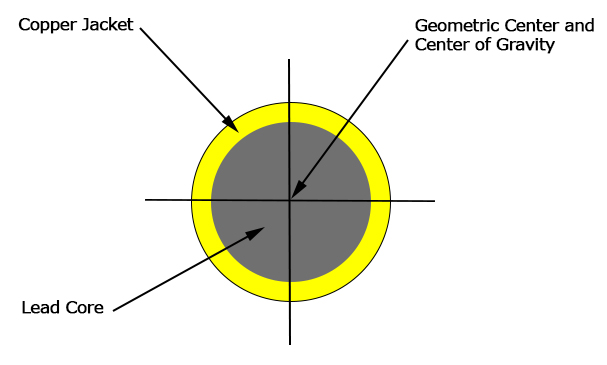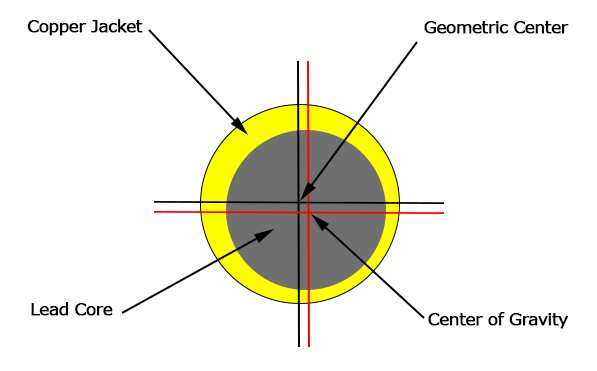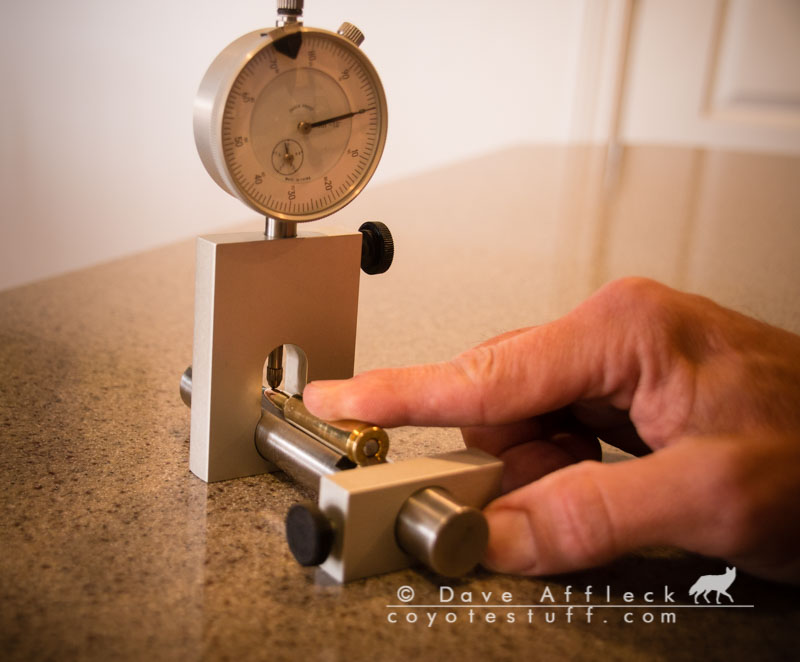Concentricity and CG Offset
Concentricity is important to accuracy because concentricity is related to bullet imbalance, or center of gravity offset, CG offset for short. And CG offset is one of the biggest causes of bullet dispersion.
So let’s talk about CG offset. What it is, how it effects accuracy and some of the common ways it gets created.
Chamber and Throat Concentricity
It’s quite common in production rifles that the chamber and throat are not perfectly concentric with the bore centerline but are instead off center. This is due to high speed, mass production methods used.
If the chamber and throat are not concentric with the centerline of the bore, or are oversized, or both (not uncommon), the bullet will not have a perfectly straight path to the centerline of the bore. The bullet may make some lateral contact in the throat before it lines up to enter the bore (the technical term for this lateral motion and contact is balloting). This side contact can cause asymmetrical deformation of the bullet. A very slight amount of in bore canting is also possible. The result of even the slightest canting or asymmetrical deformation is the bullet center of gravity will then be offset from the geometric centerline of the bullet itself and the center line of the bore. We call this, CG offset or bullet imbalance.



How CG Offset Hurts Accuracy
Bullet imbalance is one of the biggest causes of bullet dispersion. We typically refer to bullet imbalance in terms of CG offset. CG (center of gravity) offset is where the center of gravity of the bullet is offset from the geometric axis or center line of the bullet. With CG offset, we have an unnatural condition where the bullet is forced to rotate about the geometric axis or center of form while inside the barrel. But a spinning projectile always wants to spin on its principal axis (center of gravity) when free to do so. So, the instant it leaves the muzzle the bullet will start to spin around its CG. But, anytime there is any CG offset, a tangential velocity component is produced while the bullet is travelling through the bore. This tangential velocity becomes lateral drift velocity when the bullet exits the bore. The direction of the lateral drift is perpendicular to the plane passing through both the geometric and principle axes at the instant of muzzle exit. The distance that the bullet will be deflected on target can be calculated by multiplying this lateral drift velocity by the time of flight.
How Much CG Offset Hurts Accuracy
So, CG offset will absolutely cause bullet dispersion on target. The distance by which CG offset will cause a miss was first calculated mathematically by Franklin Mann (The Bullet’s Flight) over 100 years ago and has since been refined by such ballisticians as Robert McCoy (Modern Exterior Ballistics: The Launch and Flight Dynamics) and Harold Vaughn (Rifle Accuracy Facts).
Some approximate values for a bullet with a BC of .300 and a MV of 3500 fps are:
.0001 CG offset results in .200 miss at 100 yards.
.0002 CG offset results in .400 miss at 100 yards.
.0004 CG offset results in .800 miss at 100 yards.
Note, those are CG offsets in the ten thousandths of an inch. You can see that it doesn’t take much CG offset to potentially ruin your groups. And you can see why CG offset is truly one of the biggest causes of bullet dispersion.
If you could always line up the CG offset in the chamber exactly the same, all the bullets would deflect in the same direction (but by different amounts, according to the amount of CG offset). But, alas, in our real world, the direction of deflection is completely random.
Bullet Jacket Quality Affects Accuracy
So we’ve discussed what CG offset is and how it directly affects group sizes. And we’ve covered one common source for CG offset in the non-concentric production chamber. Now let’s talk about an almost constant source of CG offset in the bullets we use.
Some amount of CG offset is built-in to virtually all commercially made rifle bullets. The source of this built-in CG offset is circumferential variation in copper jacket thickness. Because lead is much heavier than copper, if one side of the jacket is thinner than the other, the lead core will be offset from the geometric center line of the bullet and so the center of gravity (CG) will be offset from the geometric axis of the bullet. Built-in bullet imbalance or CG offset. Right out of the box!


The good news is that most of the bullets in a box of commercially made hunting bullets these days will have less than .0002 CG offset due to jacket thickness variation. That is amazingly good when you think about mass production of bullets. The bad news is that in some boxes, there will be a few bullets with .0003 or more CG offset. With occasional examples being even worse. And we really have no way of knowing. When a company offers a line of “match” bullets, they usually have a tighter tolerance for the jackets vs. the regular hunting bullets.
This is why bench rest shooters use custom made bullets using only the most concentric jackets available which are held to less than .0001 thickness variation. If you hope to consistently shoot five shot groups of .200 or better at 100 yards, you can’t get there without bullet jackets held to .0001 or better concentricity.
An interesting tidbit from the book Rifle Accuracy Facts by Harold Vaughn. Mr. Vaughn designed and built a device to measure dynamic bullet imbalance. He measured the CG offset for a box of 100 hunting bullets and found that most had less than .0002 CG offset but about 30 out of the 100 had between .0002 and .0004 CG offset. Remember from above that an offset of .0004 will cause a deflection of .800 at 100 yards. But, remember too, that in our real world use, the direction of the deflection is completely random. So is the amount of CG offset in any bullet. For the box of bullets measured here, 7 out of 10 have an offset of .0002 or less so deflect only .400 of less. But 3 out of 10 could deflect by as much as .800. Both amount and direction of deflection totally random! What I find really interesting is that Vaughn created a computer simulation to “fire” five shot groups using random bullets from the CG offset data he had measured. For 100 groups fired, the average group size (caused by CG offset alone) was .700, the best group was .300 and the worst was 1.300. Does this sort of group average and variation sound familiar? I think anyone who has done much load work and rifle tuning with hunting bullets has seen results like that. With the occasional spectacular group and the occasional stinker alongside the average.
There are many factors that can account for group size in the real world, but make no mistake, CG offset due to jacket thickness variation is living large in our group sizes! And may very well sometimes explain the occasional really good or really lousy group.
Concentric Ammo Helps Accuracy
We’ve covered the sources of CG offset that are baked into production rifles and production bullets. Knowing all that, it’s amazing that our factory rifles and factory bullets shoot as well as they do. It’s a testament to modern manufacturing and quality control. But now let’s talk about one more cause of CG offset that we actually have complete control over and that is how concentric our handloads are.
Just like the non-concentric chamber, our non-concentric handloads can lead to increased CG offset and decreased accuracy. The concentricity of loaded rounds is usually expressed as Total Indicated Runout, or TIR or just “runout” for short. This is the amount of non-concentric movement measured near the tip of the bullet when the loaded round is spun in a fixture.

Runout of several thousandths can result in exactly the same kind of asymmetrical bullet deformation as bullet balloting in a non-concentric chamber as described in the first section. If you have a nicely concentric chamber, feeding it nicely concentric ammo will assure that you aren’t creating CG offset where it doesn’t already exist.
Fortunately, loading ammo with really excellent concentricity is easy. Many hand loaders who have never owned a concentricity gage have been producing nicely concentric ammo for decades without ever giving it a thought or making any special effort.
There are a lot of specialized loading tools and dies on the market designed specifically to minimize runout. I use many of these tools such as bushing dies and competition seaters, along with loading practices very specifically intended to make certain my handloads are as close to perfectly concentric as possible. I go all out, with neck turning, tight necked chambers, bushing dies, never using expanders etc. And my handloads generally have runout of less than .001.
However, the simple fact is, that excellent concentricity can be had from nearly any reloading press and dies, even the least expensive. And, it often takes no special effort. Just setup and use your equipment according to the manufacturer’s instructions and you will usually end up less than .003 runout without even really trying.
But, sometimes, not! Occasionally, poor concentricity will be produced. But armed with knowledge of concentricity and perhaps a gage to measure results, I believe almost any press and die combination can be setup to produce nice straight ammo. If you don’t have a concentricity gage, simply rolling your loaded ammo across a flat surface like a glass table top and watching to see if the tips wiggle can tell you all you really need to know for quality hunting ammo. But of course there is no harm in buying a concentricity gage and doing everything you can to produce perfect concentricity like I do. But, no matter where you are at on the equipment, do be aware of concentricity – it really does matter.
– DAA




After checking handloaded ammo for concentricity and finding some are “out”, how are they fixed?
Well, the way I go about my hand loading procedures, I don’t try and fix them after the fact.
The way I use the gauge, is to check concentricity at each step, starting with making sure the necks are concentric after sizing. If I find unacceptable concentricity at any point, I stop and figure out where it’s coming from and correct it in the process so that it’s not happening anymore, so that the finished ammo is all as good as I can make it. So I really don’t end up with some good and some not so good. They’re all good.
But there are tools on the market that both measure concentricity and have features built in to correct non-concentricity. I’ve never used any of these, my philosophy is just to find and eliminate the sources of non-concentricity throughout the process so there isn’t any crooked ammo to be fixed when I’m done.
Dave, thanks for the great articles. I have a tremendous problem with nonconcentric brass (lapua, 30-06) that seems to originate from the neck resizing process. I started with RCBS, then moved on to Redding S type (bushing), and now use a Lee Collet neck sizer. This last has been the only one that has worked somewhat consistently, though I’d sat 30% of my rounds are still >.002 (my personal standard for acceptability). I read much about how wonderful the Reddings are and wonder if my technique is flawed. any ideas? I use an RCBS Rockchucker press…
John, from here, best I can do is throw out some guesses.
Assuming the runout is coming from the neck sizing and not the seating operation here. I have no personal experience with the collet dies but they have an excellent, long standing reputation for good concentricity. Have you measured neck thickness variation of the cases? It really shouldn’t matter with a collet die, but I wonder none the less. It would be interesting to know if it is the same cases showing runout every time, or if it is random. If it’s the same cases, you can look at culling or correcting (annealing, perhaps?).
For the bushing dies, to get consistently best results, you should either sort the brass by neck thickness variation and cull any that don’t meet your standards, or outside neck turn. If you aren’t outside neck turning, you should probably use the expander – but the expander is a common source of runout. If you are outside neck turning, definitely do not use the expander, this is the system I like to use.
Anyway, for a starting point, I might mark a few of the cases that end up with runout, and see if they continue to have runout in future loadings. If so, that’s a good clue to go forward with.